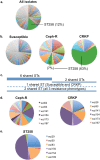Population Structure of Klebsiella pneumoniae Causing Bloodstream Infections at a New York City Tertiary Care Hospital: Diversification of Multidrug-Resistant Isolates
- PMID: 25878348
- PMCID: PMC4473223
- DOI: 10.1128/JCM.03455-14
Population Structure of Klebsiella pneumoniae Causing Bloodstream Infections at a New York City Tertiary Care Hospital: Diversification of Multidrug-Resistant Isolates
Abstract
Despite the growing importance of carbapenem-resistant Klebsiella pneumoniae (CRKP), the clonal relationships between CRKP and antibiotic-susceptible isolates remain unclear. We compared the genetic diversity and clinical features of CRKP, third-generation and/or fourth-generation cephalosporin-resistant (Ceph-R) K. pneumoniae, and susceptible K. pneumoniae isolates causing bloodstream infections at a tertiary care hospital in New York City between January 2012 and July 2013. Drug susceptibilities were determined with the Vitek 2 system. Isolates underwent multilocus sequence typing and PCR sequencing of the wzi and blaKPC genes. Clinical and microbiological data were extracted from patient records and correlated with molecular data. Among 223 patients, we identified 272 isolates. Of these, 194 were susceptible, 30 Ceph-R, and 48 CRKP, belonging to 144 sequence types (STs). Susceptible (127 STs) and Ceph-R (20 STs) isolates were highly diverse. ST258 dominated CRKP strains (12 STs, with 63% ST258). There was minimal overlap in STs between resistance groups. The blaKPC-3 gene (30%) was restricted to ST258/wzi154, whereas blaKPC-2 (70%) was observed for several wzi allele types. CRKP infections occurred more frequently among solid organ transplant (31%) and dialysis (17%) patients. Mortality rates were high overall (28%) and highest among CRKP-infected patients (59%). In multivariable analyses, advanced age, comorbidities, and disease severity were significant predictors of 30-day mortality rates, whereas the K. pneumoniae susceptibility phenotype was not. Among CRKP infections, we observed a borderline significant association of increased mortality rates with ST258 and the wzi154 allele. Although the clonal spread of ST258 continues to contribute substantially to the dissemination of CRKP, non-ST258 strains appear to be evolving. Further investigations into the mechanisms promoting CRKP diversification and the effects of clonal backgrounds on outcomes are warranted.
Copyright © 2015, American Society for Microbiology. All Rights Reserved.
Figures


References
-
- Centers for Disease Control and Prevention. 2013. Antibiotic resistance threats in the United States, 2013. Centers for Disease Control and Prevention, Atlanta, GA: http://www.cdc.gov/drugresistance/threat-report-2013.
-
- Kitchel B, Rasheed JK, Patel JB, Srinivasan A, Navon-Venezia S, Carmeli Y, Brolund A, Giske CG. 2009. Molecular epidemiology of KPC-producing Klebsiella pneumoniae isolates in the United States: clonal expansion of multilocus sequence type 258. Antimicrob Agents Chemother 53:3365–3370. doi:10.1128/AAC.00126-09. - DOI - PMC - PubMed
-
- Munoz-Price LS, Poirel L, Bonomo RA, Schwaber MJ, Daikos GL, Cormican M, Cornaglia G, Garau J, Gniadkowski M, Hayden MK, Kumarasamy K, Livermore DM, Maya JJ, Nordmann P, Patel JB, Paterson DL, Pitout J, Villegas MV, Wang H, Woodford N, Quinn JP. 2013. Clinical epidemiology of the global expansion of Klebsiella pneumoniae carbapenemases. Lancet Infect Dis 13:785–796. doi:10.1016/S1473-3099(13)70190-7. - DOI - PMC - PubMed
Publication types
MeSH terms
Grants and funding
LinkOut - more resources
Full Text Sources
Medical

